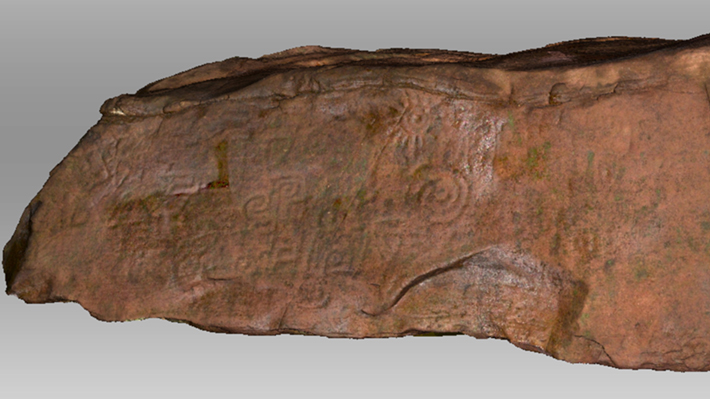2,000-Year-Old Monolith Engravings Recorded in Peru
A 2000-year-old jungle monolith decorated with circles, spirals and feline fangs has been 3D scanned in its remote Peruvian location.
Peru is a land of history, myths, and home of some of the most amazing ancient civilizations to ever live on Earth. Inhabited by various ancient cultures such as the Inca or the Tiwanaku and Nazca people, Peru is also home to some of the oldest pyramids ever erected in South America.
The ancient city-state of Caral, for example, was home to people who created some of the most impressive pyramids ever constructed in this part of the world.
But Peru hides many other secrets.
One such secret is a massive one-ton monolith believed to be around 2,000 years old. Not many people know about it, and only a few explorers have seen and documented its existence. Decorated with spirals, circular patterns, and fangs of a deity, the massive rock lies hidden in the north of the Peruvian jungle.
Despite the fact that locals knew of its existence, never has the massive monolith actually been submitted to analysis. Now researchers decided to investigate the massive rock, to see what they could learn. Scientists performed a three-dimensional scan that revealed several engravings adorning its surface.
The images and patterns are so abstract and ornate that they are difficult to describe in words. However, the researchers say that two fangs carved into the rock represent a deity known in archeology as “winged feline figure.”

Reaching the location of the monolith is no easy task. To get there, the researchers began the trip from the town of Leymebaba. Their journey took them on a massive adventure: “we hiked, ran, rode horses through jungles from 6,000 feet [1,800 meters] up to 13,000 feet [4,000 m] to this really remote village where literally nobody goes,” explained Jason Kleinhenz, an application engineer at Exact Metrology, who scanned the monolith in an interview to Live Science.
The goal of the mission was to thoroughly document the monolith and its symbols, using an Artec 3D scanner, especially because the engravings on its surface are in danger of being lost forever due to wind and rain erosion.
Since the stone had remained unstudied and exposed to torrential rains, researchers feared that once they reached the monoliths location, the symbols had disappeared.
However, this was not the case.
Thankfully, when researchers finally arrived at the location where the massive monolith remained hidden, they found a plethora of symbols on its surface. sing their 3-D scanner, the researchers were able to find and document symbols that remained invisible to the naked eye, like the fangs of a winged feline figure. It is precisely this feline figure that helped experts date the massive rock and its symbols.
According to experts, the winged feline engraving indicates that the symbols that carved on the surface of the monolith were created during what archaeologists call the “formative period,” which occurred between 200 BC. and 200 A.D. Researchers note that despite the fact that there were no writings in Peru at that time, studies of other related archeological sites showed that this figure was popular in the area.
Fernandez-Davila stressed that the monolith was likely of great importance and may have been associated with other similar structures. “It’s iconic … only people of that period can carve it the way that it is,” Fernandez-Davila explained. The researchers further explained that the jungle valley where the monolith was placed was most likely “a very important and sacred place.”
What is extremely interesting is the fact that the monolith–which weighs around one ton, and is three meters long, 76 centimeters high and 1.5 meters wide–is made of sedimentary rock that is not found locally, which means that whoever carved it most likely hauled it into the jungle valley from somewhere else.
Dragging the monolith to its present location, though the dense jungle would have been an extremely difficult task, and likely required many people.
“That itself was a tremendous effort, a communal effort definitely,” Fernandez-Davila explained. Evidence that the area where the monolith was located was of great importance is the fact that during the Inca built two baths in close proximity of the monolith, around the 15th century AD.
To understand more about the area, the culture that may have carved the monolith, and the rock itself, researchers plan future expeditions that will hopefully reveal more clues and solve yet another ancient mystery.
Oddly the symbols engraved on top of the Peruvian monolith bear a certain resemblance to another monolith located in Brazil. The Pedra do Inga is a 6,000-Year-Old ancient monolith located in the interior of the Brazilian state of Paraíba. Most of the symbols etched on its surface are thought to depict animals, fruits, humans, constellations, but also a plethora of yet unrecognizable symbols and images. Its most striking symbols are believed to depict stars, the Milky Way as well as the constellation of Orion.

The Pedra do Inga is much more massive than its Peruvian counterpart: it covers an area of approximately 250 square meters. Although it is difficult to ascertain the age of the rock, experts have proposed that rock formation and its mysterious symbol could be up to six thousand years old.
To date, experts have identified more than 400 engravings on the stone’s surface. Some of the spirals and circles depicted on the Peruvian Monolith bear a strange resemblance to the symbols etched on the Pedra do Inga in Brazil. Is it possible that both monoliths have astronomical importance? If the symbols etched on the Pedra do Inga depict constellations and galaxies, could the symbols on the Peruvian monolith convey the same meaning?
Are these two stones meant to convey the same message left behind by our ancestors? Did the same civilization create them? Does the Peruvian monolith also depict constellations and stars? Further studies will tell.
